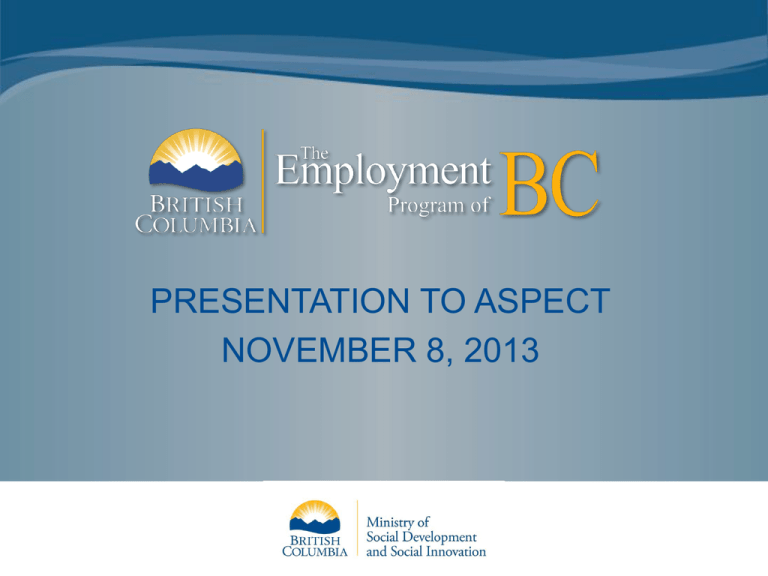Update from Ministry of Social Development and Social
advertisement

PRESENTATION TO ASPECT NOVEMBER 8, 2013 EPBC Introduction • Launched April 2, 2012 • 85 WorkBC Employment Services Centres (ESCs) in communities across the province • Over 100 Satellite Offices - outreach & itinerant services • Services to any unemployed British Columbian – full suite of services, including for specialized populations (eg: Youth, PWD, Aboriginal) • Administered by 73 contracts each responsible for a geographic area • Budget 2013/14 : LMDA: $221 million Provincial: $55 million Slide 2 Employment Program of BC Key Components • Assist British Columbians in obtaining sustainable work opportunities as quickly as possible with a focus on individuals’ strengths and abilities • Responsive to economic conditions, labour market changes and local needs • Deliver employment and labour market services in partnership with other provincial ministries, community organizations and employers 3 The Employment Program of British Columbia Employment Program of BC Key components cont’d… • Single point of entry of integrated employment and labour market services and supports to clients, employers and communities • Specialized services to all eligible clients through every ESC across the province • An information management and technology system that supports integrated service delivery and performance management 4 The Employment Program of British Columbia Basic Eligibility Criteria Basic Eligibility: Clients must be confirmed as Unemployed and legally eligible to work in BC. Clients who meet Basic Eligibility can: • Participate in Employment Focused Self-Serve group Workshops • Receive Job Search and Job Start Program Financial Supports , when determined essential by the EPBC Service Provider • Access Case Management if assessed as needing more than Self-Serve Services alone Clients Served EI Clients BCEA Clients Specialized Populations General Clients Clients Receiving Services • EPBC launch* • Client volumes have surpassed pretransition levels 113,477 people have received EPBC services since the program start • • • • • Of these: 83% (94,276) received services through an employment case manager 11% (12,184) are non case managed apprentices the balance (6,387) benefited from self serve services available through EPBC 65,121 people were actively receiving services through EPBC Specialized populations represent 65% of all active case managed files Data on this slide is for the period ending September 30, 2013 Page 7 Employment Outcomes • 23,963 Employment Outcomes and 538 Community Attachment Outcomes (e.g. Unpaid work experience)have been achieved. • 45% of clients who no longer in case management have achieved an employment outcome. Data on this slide is for the period ending September 30, 2013 Page 8 EPBC Client Distribution Non Specialized Population 36% Specialized Population 64% • Specialized Populations continue to make up over 60% of case managed clients • This percent has remained steady since reporting commenced Average Client Tier Distribution Tier 4 10% Tier 1 2% Tier 2 44% Tier 3 44% • Tier 2 & Tier 3 clients continue to account for the majority of case managed clients. • Even with Job Search and Job Start clients being counted as Tier 1, there has not been any increase to this client category. Percent of Case Managed Clients by Specialized Populations Type • Each specialized population has been growing steadily Since program launch • Clients who self-identified as Youth or Persons with a Disability continue to be the top two categories in all Specialized Populations What does all of this mean? • Client volumes have risen steadily since EPBC launch and now similar to 2009/10 levels • Over half of active cases are in Tiers 3 and 4 but less than 10% of clients are in some form of long-term service intervention • Nearly 80% of clients receive only case management and ESS topics • While Placement, Supplemental, and STOC managed services are to shown to lead to higher client outcomes,Year only a small percentage of Date clients access these services Risks • Underutilization of the full range of program services clients may need and be eligible for • Clients from specialized populations may not be receiving services designed to support them in attaching to the labour market • Referral levels to specialized services impacts sub-contractors ability to remain operational (e.g. Customized Employment) Year to • Budget risks associated with ongoing program budget under-spending Date • Unknown impacts of LMA negotiations Moving Forward • The Ministry remains committed to work towards resolving concerns associated with fee structure and streamlining administrative processes • A joint strategy with Contractors is being developed on resolving the outstanding program risks as demonstrated by data analysis is needed, in particular: – Clients receive services they are eligible for and need to move to employment, – Clients with barriers to employment, such as those from Specialized Populations, receive supports to improve their employment readiness; and – Service delivery partners are supported in the delivery of services to all clients. • Continuing to leverage Best Practices Page 14 Beyond Barriers Symposium • February 25, 26 and 27th 2014 in Vancouver, Sheraton Wall Centre • Offering a variety of workshops and expert that relate to the Specialized Populations and the EPBC Program overall. • Requesting feedback from contractors and service providers on the topics and speakers Slide 15 Community and Employer Partnerships Vision: Increase employment and work experience outcomes in communities through partnerships, shared information and innovative practices Budget 2013/14: $8 million Job Creation Partnerships: • funding to organizations for local projects to provide benefits to the job seeker, community and the local economy Labour Market Partnerships: • Funding to organizations to address local labour market or human resources issues through strategic partnerships with other labour market stakeholder organizations • Employer Sponsored Training (EST) - financial assistance to employers to support training activities for employees who would otherwise lose their jobs Page 16 BC Centre for Employment Excellence • Single coordination point for research and innovation • Sharing best practice resources, tools and training for employment services sectors and employers • $2 Million over three years • Garnered attention nation-wide Slide 17 QUESTIONS? Page 18
















